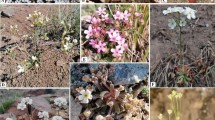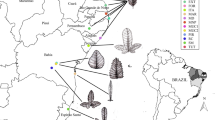Abstract
An investigation into the potential taxonomic value of leaf surface characteristics using large sample size and multivariate analysis was undertaken in Carex section Phacocystis. A case study examined micromorphological characters of the leaf surface for six members of the section in Britain. The six split into three groups based on distribution of stomata: Carex recta amphistomous, C. aquatilis/C. nigra epistomous, and C. bigelowii/C. elata/C. acuta hypostomous. There was considerable variation within samples in stomatal density and cell dimensions. Discriminant Analysis of nine quantitative characters clearly separated four species and a cluster of two species, C. elata and C. acuta. Multivariate analysis indicated that the intercostal cell lengths from both leaf surfaces, abaxial costal cell lengths, and widths of the adaxial costal and abaxial intercostal cells were taxonomically useful in this group and potentially of use within the genus.



Similar content being viewed by others
References
Akiyama S (1941) On the systematic anatomy of the leaves of some Japanese Carices XXXII. Bot Mag-Tokyo 55:124–130
Claustres G, Le Cohu M-C (1965) Intérêt des éléments épidermiques de la feuille et de l’utricle dans la taxinomie des Carex. C R Ac Sci Paris 260:4373–4376
Crawford FC (1910) Anatomy of the British carices. Oliver and Boyd, Edinburgh
de Oliveira Plotze R, Falvo M, Gomes Pádua J, Bernacci LC, Carniero Vieira ML, Xavier Oliveira GC, Martinez Bruno O (2005) Leaf shape analysis using the multiscale Minowski fractal dimension, a new morphometric method: a study with Passiflora (Passifloraceae). Canad J Bot 83:287–301
Dunlop DA (1990) The biosystematics of Carex section Scirpinae (Cyperaceae). Unpubl. D. Phil. thesis. University of New Hampshire
Faulkner JS (1972) Chromosome studies on Carex section Acutae in northwest Europe. Bot J Linn Soc 65:271–301
Flatberg KI (1972) Carex x lidii Flatb. = C. canescens L. x chordorrhiza Ehrh., a new hybrid. Norw J Bot 19:91–106
González-Rodríguez A, Oyama K (2005) Leaf morphometric variation in Quercus affinis and Q. laurina (Fagaceae), two hybridizing Mexican red oaks. Bot J Linn Soc 147:427–435
Hjelmqvist AH, Nyholm E (1947) Några anatomiska artkaraktärer inom Carex-gruppen Distigmaticae. Lund
Jalas J, Hirvelä U (1964) Notes on the taxonomy and leaf anatomy of Carex elata All., C. omskiana Meinsh. and C. x turfosa Fr. Ann Bot Fenn 1:47–54
Jermy AC, Chater AO, David RW (1982) Sedges of the British Isles. Botanical Society of the British Isles, London
Kukkonen I (1970) Vegetative anatomy of Carex microglochin Wahlenb. and Carex camptoglochin Krech. Bot J Linn Soc Suppl 1:137–145
Le Cohu M-C (1967) Recherches taxinomiques sur les Carex du Massif Armoricain. Bot Rhedonica sér A 3:1–213
Le Cohu M-C (1971) Les charactères épidermiques des Carex de la section Acutae. C R Acad Sci Paris Ser D 272:2075–2077
Mabberley DJ (1997) The plant book. Cambridge University Press, Cambridge
Meade C, Parnell J (2003) Multivariate analysis of leaf shape patterns in Asian species of the Uvaria group (Annonaceae). Bot J Linn Soc 143:231–242
Metcalfe CR (1971) Anatomy of the monocotyledons. vol V. The Cyperaceae. Oxford University Press, Oxford
Molina A, Acedo C, Llamas F (2006) The relationship between water availability and anatomical characters in Carex hirta. Aquat Bot 85:257–262
Nagamitsu T, Kawahara T, Hotta M (2004) Phenotypic variation and leaf fluctuating asymmetry in isolated populations of an endangered dwarf birch Betula ovalifolia in Hokkaido, Japan. Pl Spec Biol 19:13–21
Persson HA, Gustavsson BA (2001) The extent of clonality and genetic diversity in lingonberry (Vaccinium vitis-idaea L.) revealed by RAPDs and leaf-shape analysis. Molec Ecol 10:1385–1397
Reznicek AA, Catling PM (1986) Vegetative shoots in the taxonomy of the sedges (Carex, Cyperaceae). Taxon 35(5):495–501
Rice JS, Glenn EM, Quisenberry VL (1979) A rapid method for obtaining leaf impressions in grasses. Agron J 71:894–896
Rich TCG, Jermy AC (1998) Plant crib 1998. Botanical Society of the British Isles, London
Sivarajan VV (1991) Introduction to the principles of plant taxonomy. Cambridge University Press, Cambridge
Spinner H (1902) L’anatomie foliaire des Carex suisses. Bull Soc Sci Nat T 30:65–81
Stace CA (1984) The taxonomic importance of the leaf surface. In: Heywood VH, Moore DM (eds) Current concepts in plant taxonomy. Academic Press, London, pp 67–94
Standley LA (1983) A clarification of the status of Carex crinita and C. gynandra (Cyperaceae). Rhodora 85:229–241
Standley LA (1985) Systematics of the Acutae group of Carex (Cyperaceae) in the Pacific Northwest. Syst Bot Monogr 7:1–106
Standley LA (1986) Variation in stomatal distribution in Carex aquatilis (Cypeaceae). Amer J Bot 73:1393–1399
Standley LA (1987a) Anatomical and chromosomal studies of Carex section Phacocystis in Eastern North America. Bot Gaz 148:507–518
Standley LA (1987b) Anatomical studies of Carex cuchumatanensis, C. decidua, and C. hermanii (Cyperaceae) and comparisons with North American taxa of the C. acuta complex. Brittonia 39:11–19
Standley LA (1990a) Anatomical aspects of the taxonomy of sedges (Carex, Cyperaceae). Canad J Bot 68:1449–1456
Standley LA (1990b) Allozyme evidence for the hybrid origin of the maritime species Carex salina and Carex recta (Cyperaceae) in eastern North America. Syst Bot 15(2):182–191
Starr JR, Ford BA (2001) The taxonomic and phylogenetic utility of vegetative anatomy and fruit epidermal silica bodies in Carex section Phyllostachys (Cyperaceae). Canad J Bot 79:362–379
Timonen T, Toivonen H (1979) Gross and micromorphological comparison of Carex furva and C. lachenalii. Ann Bot Fenn 16:11–17
Toivonen H (1980) Carex canescens x mackenziei. A comparative study of two Carex species and their spontaneous hybrid. Ann Bot Fenn 17:91–123
Toivonen H (1981) Spontaneous Carex hybrids of Heleonastes and related sections in Fennoscandia. Acta Bot Fenn 116:1–51
Veres JS, Williams III GJ (1985) Leaf cavity size differentiation and water relations in Carex eleocharis. Amer J Bot 72:1074–1077
Author information
Authors and Affiliations
Corresponding author
Rights and permissions
About this article
Cite this article
Dean, M., Ashton, P.A. Leaf surfaces as a taxonomic tool: the case of Carex section Phacocystis (Cyperaceae) in the British Isles. Plant Syst Evol 273, 97–105 (2008). https://doi.org/10.1007/s00606-008-0029-8
Received:
Accepted:
Published:
Issue Date:
DOI: https://doi.org/10.1007/s00606-008-0029-8




